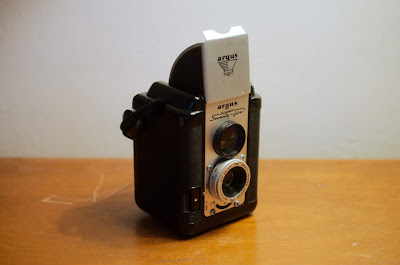Front
Rear
The Century folds into a fairly compact package. The photographer presses a hidden button on the top of the camera to release the lens bed and opens it until it locked into place. He then draws out the lens standard until it hits the infinity stops on the rails and locks it into place. The camera has limited movements on the front: rise, shift and tilt, and the bed can be dropped. The drop bed and front rise are useful to get the front of the lens bed out of the picture with wide angle lenses. The shifts are available only with lenses that have focal lengths longer than normal because otherwise the front lens standard hits the lens bed struts.
The camera has an open frame viewfinder and could come with an optional optical viewfinder. Focusing is by ground glass with the camera on a tripod, by the focusing scale located on the lens bed or by an optional Kalart coupled range finder.
The Century could be customized with a variety of lenses and shutters. This example has an f/4.5 103mm Graflex Trioptar lens made by Wollensak in a Graflex Century shutter also made by Wollensak. This was the lowest price combination. Better lenses and shutters made by Eastman Kodak Company also were available, for example the f/4.5 101mm Kodak Ektar in a Kodak Flash Supermatic shutter. Other lenses by manufacturers such as Zeiss or Schneider, and shutters such as the Compur Rapid were imported from Germany. The size of the lens board and the length of the bellows draw limit the diameter and focal length of the lenses that can be used. The focusing scales on the lens bed need to be matched to the lens for scale focusing to work. The Kalart rangefinder also needs to be adjusted to match the lens. Ground glass focusing works with any lens without any further adjustments.
A Century Graphic came with a removable ground glass back for 2-1/4" x 3-1/4" sheet film in holders, two sheets to a holder, and had a Graflok back for the optional roll film holders. The "23" roll film holder is for eight 2-1/4" x 3-1/4" pictures on 120 film. A "22" roll film holder for twelve 2-1/4" square pictures on 120 film also was available. The roll film holders had dark slides, which allowed the film holders to be removed mid-roll without wasting a picture. If you don't want to handle individual sheets of film in a darkroom, a roll film holder is desirable.
You needed to have the camera on a tripod to use ground glass focusing. You opened the shutter, focused and composed the picture on the ground glass as in a view camera, closed the shutter, set the taking aperture and shutter speed, inserted the loaded sheet film holder, pulled out the dark slide on the sheet film holder, exposed the film, replaced the dark slide and took the exposed film to the darkroom in the holder. Hand-holding the camera, you would focus using the distance scale on the lens bed or the Kalart range finder and compose the picture using the open frame finder or the optical finder. Using the roll film holder is like using any other roll film camera. When you use the roll film holder it puts your eye a little farther from the optical finder than when you use the ground glass back.
This camera attracts attention when out in public. Unfortunately the bellows on my 70 year old example has developed a light leak and it is out of commission right now. I have a replacement bellows and just need to get around to putting in the new one. The half-silvered glass beam splitter on the rangefinder has tarnished and the focusing patch is only faintly reflected. Deteriorated beam splitters are common. Replacing the beam splitter is possible, but requires cutting a replacement to fit.
A gnarly tree in Centennial Park, Nashville, Tennessee, pre-light leak.
Advertisement, Popular Photography, April, 1950.


















































